Sculpture Studio Spring 2012
/Stephanie Scott
Project 3: Site, Place, and Installation
ARTIST RESEARCH
Site-specific works engage what surrounds the sculpture itself, whether it is the interior of a building/gallery, or the location and additional elements of nature, applying additional context to what already lies within the sculpture. The works of Andy Goldsworthy and Robert Smithson emphasize and engage in their surroundings which is commonly the earth itself.
Andy Goldsworthy
“My art is an attempt to reach beyond the surface appearance. I want to see growth in wood, time in stone, nature in a city, and I do not mean its parks but a deeper understanding that a city is nature too-the ground upon which it is built, the stone with which it is made.” –Andy Goldsworthy
Andy Goldsworthy’s works engage real places, consisting specifically of site-specific earthworks. Earthworks are works created in and for specific areas. Goldsworthy’s works are created through the use of present materials, using the earth’s natural products to form sculptures of “deceptive simplicity…amazing feats of balance and timing in the process.” In many cases, his works may last only a few seconds, while others can remain for many days before being ‘reclaimed’ by nature. Notes, drawings and photographs are all that usually remain intact.
His work Neuberger Cairn (2001) is an egg-shaped sculpture, consisting of hundreds of variously shaped stones, carefully chosen. Only the weight of the stones themselves keeps the sculpture in form. Goldsworthy does not like to use bonding materials to hold the natural materials in place, preferring to use the “natural bonds and tensions that exist within the earth.”
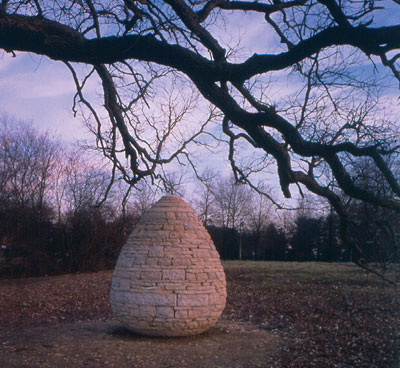
Neuberger Cairn (2001)
In another work shown in the documentary “Rivers and Tides” (2001), Goldsworthy creates a kinetic earthwork. In this picture, dozens of green leaves are connected to one another to create a line, which is placed on the surface of a stream in a spiral. The movement of the water causes the spiral to unwind and the line of leaves travels down the stream along the surface.

Image from "Rivers and Tides" (2001)
Another work comprised of leaves is Rowan Leaves Around A Hole (1987). This work consists of over a hundred leaves, each displaying a warm hue. Goldsworthy has arranged them in multiple layers in the form of a circle, from the brightest leaves at the center surrounding the black dot at the center, to the darkest on the outside. Goldsworthy’s simple arrangement emphasizes the colors that can be found in nature and the great number of variations that can be achieved.
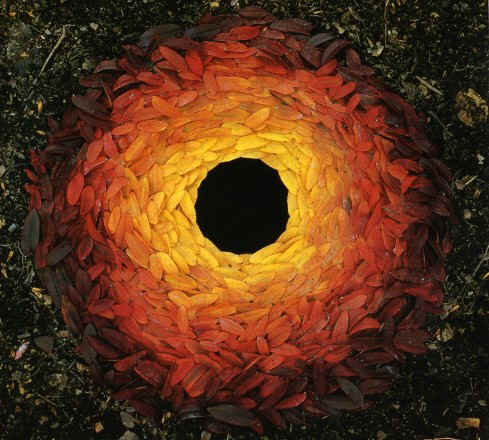
Rowan Leaves Around A Hole (1987)
Goldsworthy’s works focus on the earth and its materials. He focuses on the natural abilities of the materials, such as the variations of colors in the leaves he uses or the tensions withstood by the rocks in his stone sculptures. Goldsworthy recognizes the cycle of process and disintegration in his earthworks, stating that his “remit is to work with nature as a whole.”
Robert Smithson
“Nature does not proceed in a straight line, it is rather a sprawling development.” – Robert Smithson
Robert Smithson’s works are also examples of earthwork. Though unlike Goldsworthy’s, Smithson’s works have more permanence, either through construction or the makeup of materials.
The first earthwork completed by Smithson was Asphalt Rundown (1969). Smithson hired a dump truck to deposit hot asphalt down the side of a rock quarry on the outskirts of Rome, Italy. The hot asphalt fused with the lines of the rock as it cooled and hardened, smoothing the time-worn lines in the face of the rock. On his intention of the work, Smithson said he wanted to “root it in the contour of the land, so that it’s permanently and subject to weathering.”
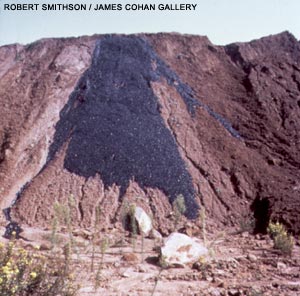
Asphalt Rundown (1969)
In another work, Mirror Shore (1969), Smithson places several square mirrors in a row into the sand of a beach in Florida. The sunlight reflects off the mirrors, casting highlights across the sand. The expanse of the highlights grows and diminishes by the amount of sunlight due to the weather or time of the day. This work was part of a series completed as Smithson traveled to different countries, where he would place mirrors in a natural setting and photograph the changes in the landscape created by the mirrors and their reflective qualities. Smithson’s intentions were to draw attention to the contrast of the natural and unnatural.
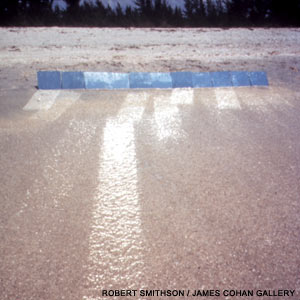
Mirror Shore (1969)
Smithson’s most famous work, Spiral Jetty (1970), consists of a large spiral made out of basalt, dirt, and sand collected from the surrounding area, reaching out into the contaminated violet-red waters of the Great Salt Lake of Utah from the lakeside. Though the work becomes submerged as the waters rise with the tides and reappears when they recede, it has remained in its original position throughout the years. Spiral Jetty is a work that connects land and water while harmonizing with the unusually colored water of the lake.
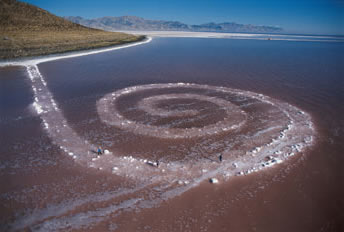
Spiral Jetty (1970)
Smithson is credited as being the father of the earthwork movement. Similar to Goldsworthy’s works, Smithson’s worked in harmony with the surrounding environment. In many cases, he calls emphasis to what surrounds the sculpture in addition to the work itself. Spiral Jetty calls attention to the unusual color of the Great Salt Lake through its winding shape, while Mirror Shore makes the viewer look closer at the contrasting textures and abilities of the unnatural, human-made mirrors and the natural, earthly characteristics of the sand.
References & Images:
http://www.kqed.org/arts/people/spark/profile.jsp?id=4157
http://www.goldsworthy.cc.gla.ac.uk/extracts/
http://www.kon.org/urc/v9/interconnected-through-art/binkly.pdf
http://www.spiraljetty.org/
http://en.wikipedia.org/wiki/Robert_Smithson
http://www.theartstory.org/artist-smithson-robert.htm
http://en.wikipedia.org/wiki/Andy_Goldsworthy
Back to Index
This page was last updated:
March 19, 2012 1:52 PM